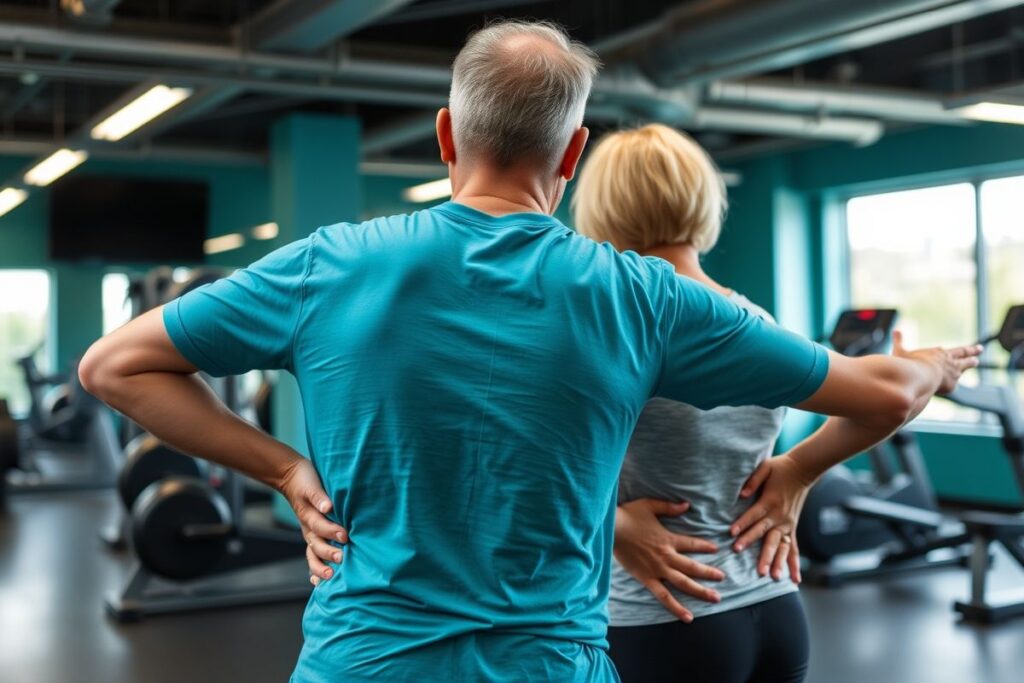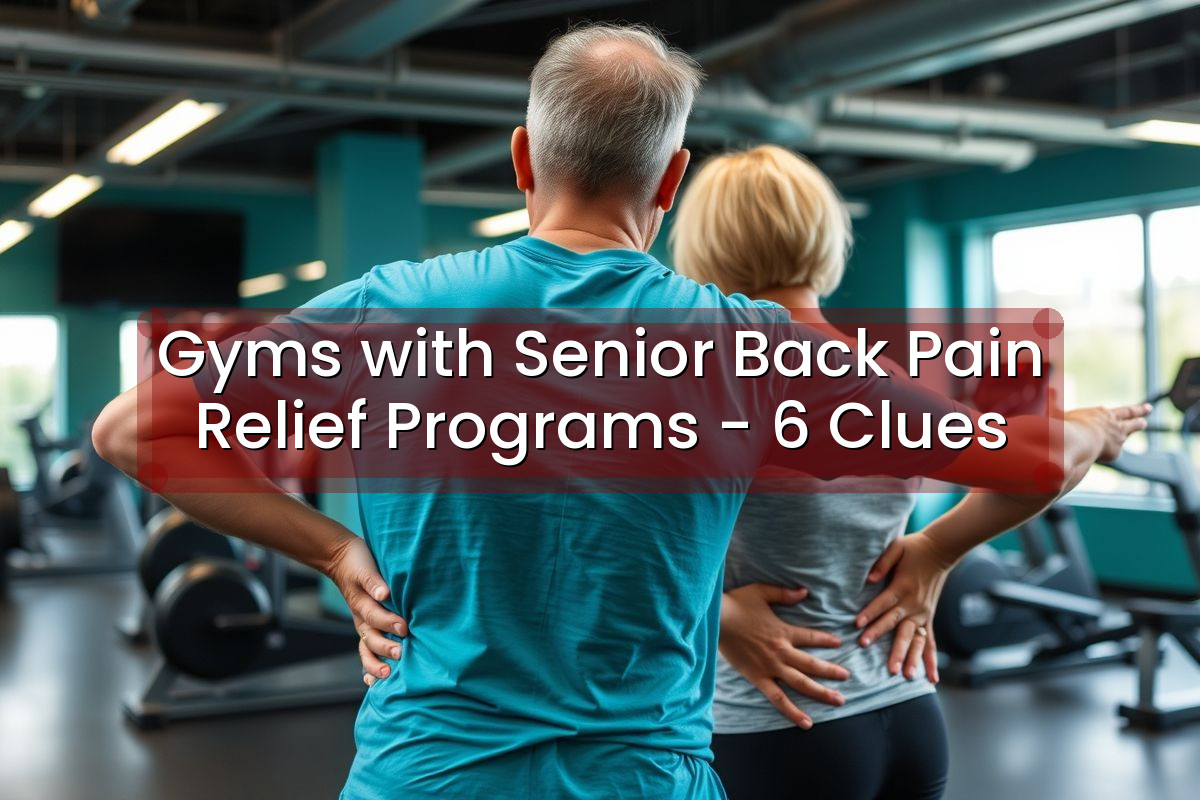Gyms with Senior Back Pain Relief Programs: 6 Clues
Back pain can significantly impact the quality of life, especially for seniors. Finding the right gym with specialized programs can be a game-changer. This isn’t about just any gym membership; it’s about targeted exercises and expert guidance to alleviate pain, improve mobility, and enhance overall well-being. This article reveals six key clues to look for when choosing a gym that truly caters to seniors with back pain.

Clue 1: Qualified Professionals
Certified Trainers
Look for gyms that employ certified trainers with experience in working with older adults and back pain. These professionals should have a deep understanding of age-related physiological changes and how they impact exercise. They should also be adept at modifying exercises to accommodate individual needs and limitations.
Certified trainers possess the knowledge and skills to design safe and effective exercise programs that address the specific causes of back pain. They can guide you through proper form and technique, minimizing the risk of injury. Certified trainers offer personalized attention, ensuring you’re progressing at a pace that’s right for you.
Check for certifications from reputable organizations such as the American College of Sports Medicine (ACSM) or the National Strength and Conditioning Association (NSCA). These certifications demonstrate a commitment to ongoing education and adherence to industry best practices.
Physical Therapists or Other Healthcare Professionals
The presence of physical therapists or other healthcare professionals on staff or as consultants is a strong indicator of a gym’s commitment to senior back pain relief. These professionals can provide valuable insights into individual conditions and develop tailored exercise plans.
Physical therapists can perform assessments to pinpoint the root causes of back pain and recommend specific exercises to address these issues. Their expertise ensures that exercises are performed correctly and are integrated into a comprehensive rehabilitation plan. Access to physical therapy within the gym setting can streamline the recovery process.
The collaboration between trainers and healthcare professionals fosters a holistic approach to managing back pain, emphasizing both exercise and overall health management.
Clue 2: Specialized Equipment
Machines Designed for Seniors
Gyms catering to seniors with back pain often feature specialized equipment designed for comfort and safety. These machines may offer adjustable resistance, supportive seating, and ergonomic designs that minimize stress on the back.
Equipment designed for seniors takes into account age-related changes in strength, flexibility, and balance. Machines with adjustable resistance allow for gradual progression, preventing overexertion. Supportive seating and ergonomic designs ensure proper posture and reduce strain on the back.
Look for equipment that specifically targets core strengthening and back muscles, as these are crucial for supporting the spine and alleviating pain.
Aquatic Therapy Options
Water-based exercises can be incredibly beneficial for seniors with back pain. The buoyancy of water reduces stress on joints, making movement easier and more comfortable. Aquatic therapy can improve flexibility, strength, and range of motion without putting excessive strain on the back.
Warm water therapy can also help to relax muscles and reduce pain. The resistance provided by water offers a gentle yet effective way to build strength and improve cardiovascular health. Aquatic therapy can be particularly helpful for those with limited mobility on land.
If aquatic therapy is a priority, look for gyms with dedicated pools or access to hydrotherapy facilities.
Clue 3: Targeted Programs
Senior-Specific Classes
Gyms that understand the unique needs of seniors often offer specialized classes designed for back pain relief. These classes might include gentle yoga, Pilates, tai chi, or other low-impact exercises that promote flexibility, strength, and balance.
Senior-specific classes provide a supportive environment where individuals can exercise at their own pace and receive guidance from qualified instructors. These classes often focus on improving posture, core strength, and range of motion, all of which are essential for managing back pain.
Check the class schedule to see if the gym offers a variety of options that cater to different fitness levels and preferences. Look for classes that emphasize proper form and technique to minimize the risk of injury.
Individualized Exercise Plans
A truly effective gym for senior back pain relief will offer individualized exercise plans. These plans should be tailored to each person’s specific needs, taking into account their medical history, current fitness level, and pain triggers.
Individualized plans ensure that exercises are appropriate and effective for managing individual back pain conditions. These plans may be developed by certified trainers, physical therapists, or other healthcare professionals. Regular assessments and adjustments to the plan are important for tracking progress and making necessary modifications.
A personalized approach to exercise is key to achieving lasting pain relief and improved function.
Clue 4: Supportive Atmosphere
Welcoming Environment
A welcoming and inclusive environment is essential for seniors seeking back pain relief. The gym should be a place where individuals feel comfortable and supported, regardless of their age or fitness level. Look for a gym with a friendly staff and a community atmosphere.
A positive and encouraging environment can motivate seniors to stick with their exercise program. A supportive atmosphere can help reduce anxiety and build confidence. Observe the interactions between staff and members to gauge the overall atmosphere of the gym.
A welcoming gym will make exercise a more enjoyable and sustainable part of a senior’s life.
Accessibility
Accessibility is crucial for seniors with mobility limitations. Ensure the gym has accessible parking, ramps, elevators, and restrooms. Equipment should be spaced appropriately to accommodate walkers or wheelchairs.
Easy access to facilities and equipment is essential for ensuring that seniors can participate fully in the gym’s programs. Consider the layout of the gym and whether it’s easy to navigate. Check for handrails and other assistive devices that may be needed.
A truly accessible gym demonstrates a commitment to inclusivity and makes exercise a viable option for all seniors.
Clue 5: Trial Periods and Flexible Memberships
A reputable gym will offer trial periods or flexible memberships to allow seniors to experience the facilities and programs before committing long-term. This allows individuals to determine if the gym is a good fit for their needs and preferences.
A trial period provides an opportunity to test the equipment, participate in classes, and interact with the staff. Flexible memberships allow seniors to adjust their commitment based on their progress and changing needs. This flexibility can be particularly important for those managing chronic pain conditions.
Take advantage of trial periods to explore different gyms and find one that meets your specific requirements.
